Business Decision Making Report: A&B plc, Semester 2 Analysis
VerifiedAdded on 2023/01/07
|7
|1496
|30
Report
AI Summary
This report delves into the critical aspects of business decision-making, focusing on the application of financial tools like payback period and net present value (NPV) to evaluate investment projects. It provides detailed calculations of payback periods for Project A and Project B, comparing their time to recover initial investments. The report also computes the NPV for both projects, considering discounted cash inflows to assess profitability. Furthermore, the analysis extends to examining the financial and non-financial factors that influence decision-making, such as legislation, employee morale, and stakeholder relationships. The report highlights the implications of these factors on various stakeholders, including owners, customers, and suppliers, and their role in the overall decision-making process. The conclusion summarizes the findings, emphasizing the importance of a comprehensive approach to business decisions that considers both financial metrics and external factors. The report suggests that Project A is the better investment for A&B plc.

Business Decision Making
Paraphrase This Document
Need a fresh take? Get an instant paraphrase of this document with our AI Paraphraser

TABLE OF CONTENTS
INTRODUCTION...........................................................................................................................1
MAIN BODY...................................................................................................................................1
Calculation of payback period....................................................................................................1
Calculation of net present value..................................................................................................2
Examining the financial and non-financial factors and also its implication on the stakeholders
and decision making process.......................................................................................................3
CONCLUSION................................................................................................................................4
REFERENCES................................................................................................................................5
INTRODUCTION...........................................................................................................................1
MAIN BODY...................................................................................................................................1
Calculation of payback period....................................................................................................1
Calculation of net present value..................................................................................................2
Examining the financial and non-financial factors and also its implication on the stakeholders
and decision making process.......................................................................................................3
CONCLUSION................................................................................................................................4
REFERENCES................................................................................................................................5
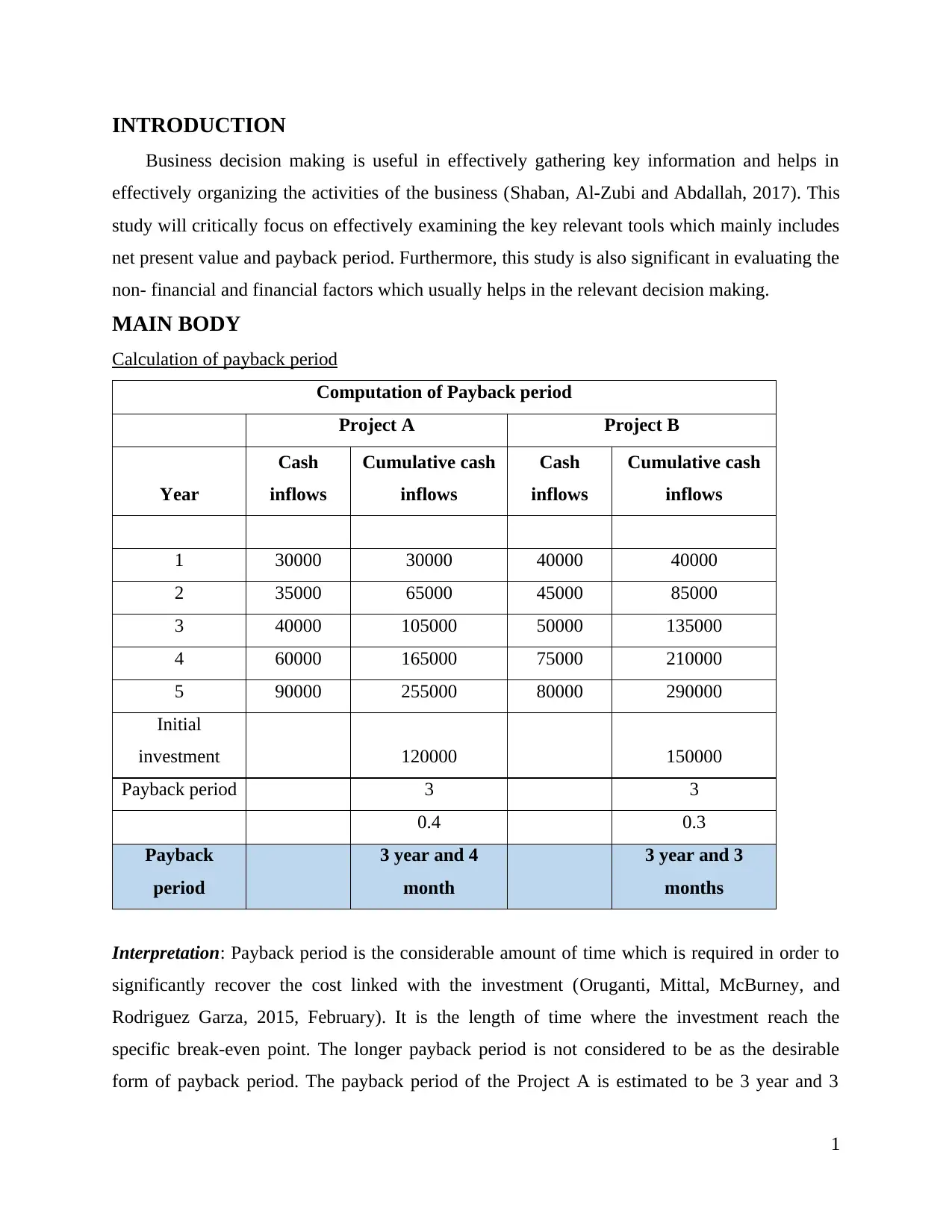
INTRODUCTION
Business decision making is useful in effectively gathering key information and helps in
effectively organizing the activities of the business (Shaban, Al-Zubi and Abdallah, 2017). This
study will critically focus on effectively examining the key relevant tools which mainly includes
net present value and payback period. Furthermore, this study is also significant in evaluating the
non- financial and financial factors which usually helps in the relevant decision making.
MAIN BODY
Calculation of payback period
Computation of Payback period
Project A Project B
Year
Cash
inflows
Cumulative cash
inflows
Cash
inflows
Cumulative cash
inflows
1 30000 30000 40000 40000
2 35000 65000 45000 85000
3 40000 105000 50000 135000
4 60000 165000 75000 210000
5 90000 255000 80000 290000
Initial
investment 120000 150000
Payback period 3 3
0.4 0.3
Payback
period
3 year and 4
month
3 year and 3
months
Interpretation: Payback period is the considerable amount of time which is required in order to
significantly recover the cost linked with the investment (Oruganti, Mittal, McBurney, and
Rodriguez Garza, 2015, February). It is the length of time where the investment reach the
specific break-even point. The longer payback period is not considered to be as the desirable
form of payback period. The payback period of the Project A is estimated to be 3 year and 3
1
Business decision making is useful in effectively gathering key information and helps in
effectively organizing the activities of the business (Shaban, Al-Zubi and Abdallah, 2017). This
study will critically focus on effectively examining the key relevant tools which mainly includes
net present value and payback period. Furthermore, this study is also significant in evaluating the
non- financial and financial factors which usually helps in the relevant decision making.
MAIN BODY
Calculation of payback period
Computation of Payback period
Project A Project B
Year
Cash
inflows
Cumulative cash
inflows
Cash
inflows
Cumulative cash
inflows
1 30000 30000 40000 40000
2 35000 65000 45000 85000
3 40000 105000 50000 135000
4 60000 165000 75000 210000
5 90000 255000 80000 290000
Initial
investment 120000 150000
Payback period 3 3
0.4 0.3
Payback
period
3 year and 4
month
3 year and 3
months
Interpretation: Payback period is the considerable amount of time which is required in order to
significantly recover the cost linked with the investment (Oruganti, Mittal, McBurney, and
Rodriguez Garza, 2015, February). It is the length of time where the investment reach the
specific break-even point. The longer payback period is not considered to be as the desirable
form of payback period. The payback period of the Project A is estimated to be 3 year and 3
1
⊘ This is a preview!⊘
Do you want full access?
Subscribe today to unlock all pages.

Trusted by 1+ million students worldwide
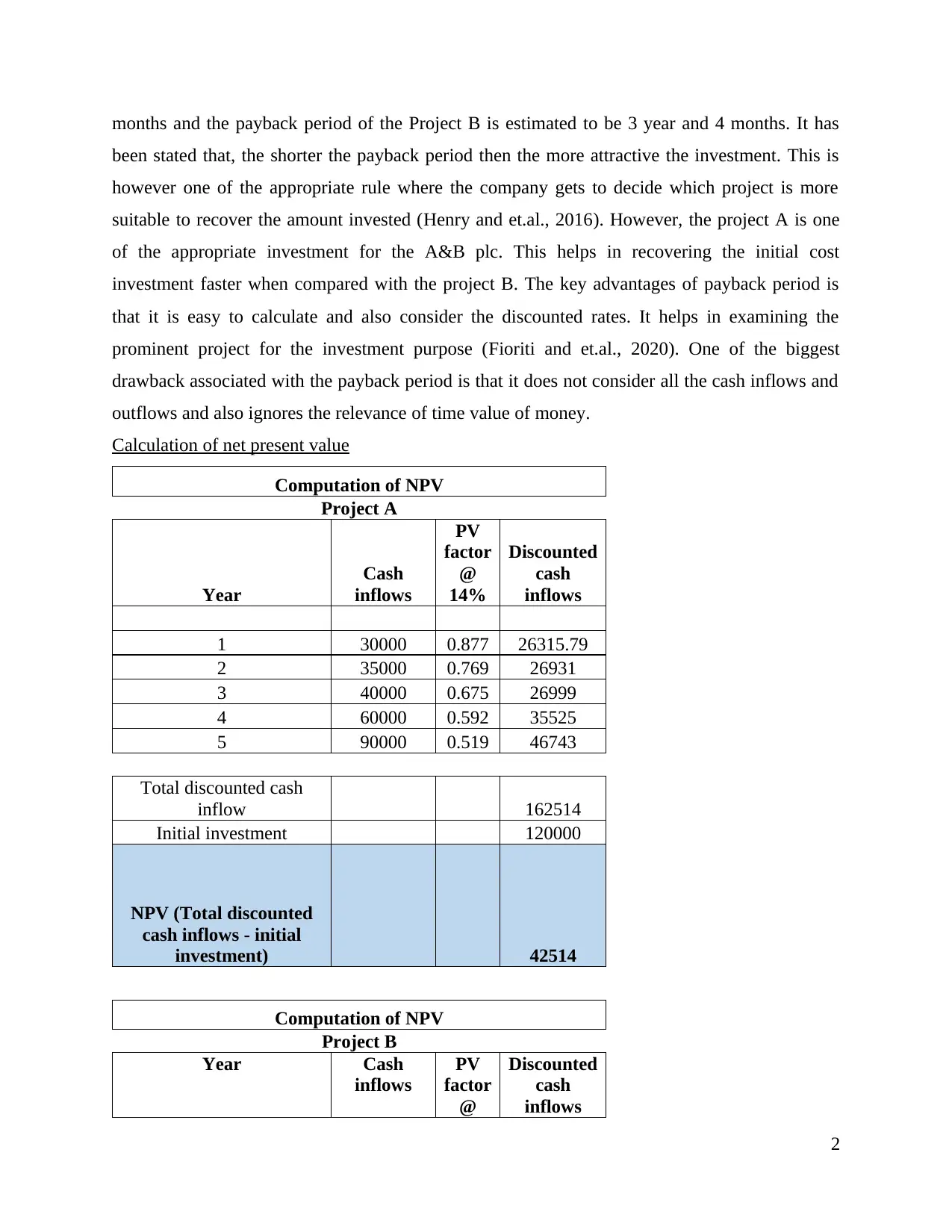
months and the payback period of the Project B is estimated to be 3 year and 4 months. It has
been stated that, the shorter the payback period then the more attractive the investment. This is
however one of the appropriate rule where the company gets to decide which project is more
suitable to recover the amount invested (Henry and et.al., 2016). However, the project A is one
of the appropriate investment for the A&B plc. This helps in recovering the initial cost
investment faster when compared with the project B. The key advantages of payback period is
that it is easy to calculate and also consider the discounted rates. It helps in examining the
prominent project for the investment purpose (Fioriti and et.al., 2020). One of the biggest
drawback associated with the payback period is that it does not consider all the cash inflows and
outflows and also ignores the relevance of time value of money.
Calculation of net present value
Computation of NPV
Project A
Year
Cash
inflows
PV
factor
@
14%
Discounted
cash
inflows
1 30000 0.877 26315.79
2 35000 0.769 26931
3 40000 0.675 26999
4 60000 0.592 35525
5 90000 0.519 46743
Total discounted cash
inflow 162514
Initial investment 120000
NPV (Total discounted
cash inflows - initial
investment) 42514
Computation of NPV
Project B
Year Cash
inflows
PV
factor
@
Discounted
cash
inflows
2
been stated that, the shorter the payback period then the more attractive the investment. This is
however one of the appropriate rule where the company gets to decide which project is more
suitable to recover the amount invested (Henry and et.al., 2016). However, the project A is one
of the appropriate investment for the A&B plc. This helps in recovering the initial cost
investment faster when compared with the project B. The key advantages of payback period is
that it is easy to calculate and also consider the discounted rates. It helps in examining the
prominent project for the investment purpose (Fioriti and et.al., 2020). One of the biggest
drawback associated with the payback period is that it does not consider all the cash inflows and
outflows and also ignores the relevance of time value of money.
Calculation of net present value
Computation of NPV
Project A
Year
Cash
inflows
PV
factor
@
14%
Discounted
cash
inflows
1 30000 0.877 26315.79
2 35000 0.769 26931
3 40000 0.675 26999
4 60000 0.592 35525
5 90000 0.519 46743
Total discounted cash
inflow 162514
Initial investment 120000
NPV (Total discounted
cash inflows - initial
investment) 42514
Computation of NPV
Project B
Year Cash
inflows
PV
factor
@
Discounted
cash
inflows
2
Paraphrase This Document
Need a fresh take? Get an instant paraphrase of this document with our AI Paraphraser
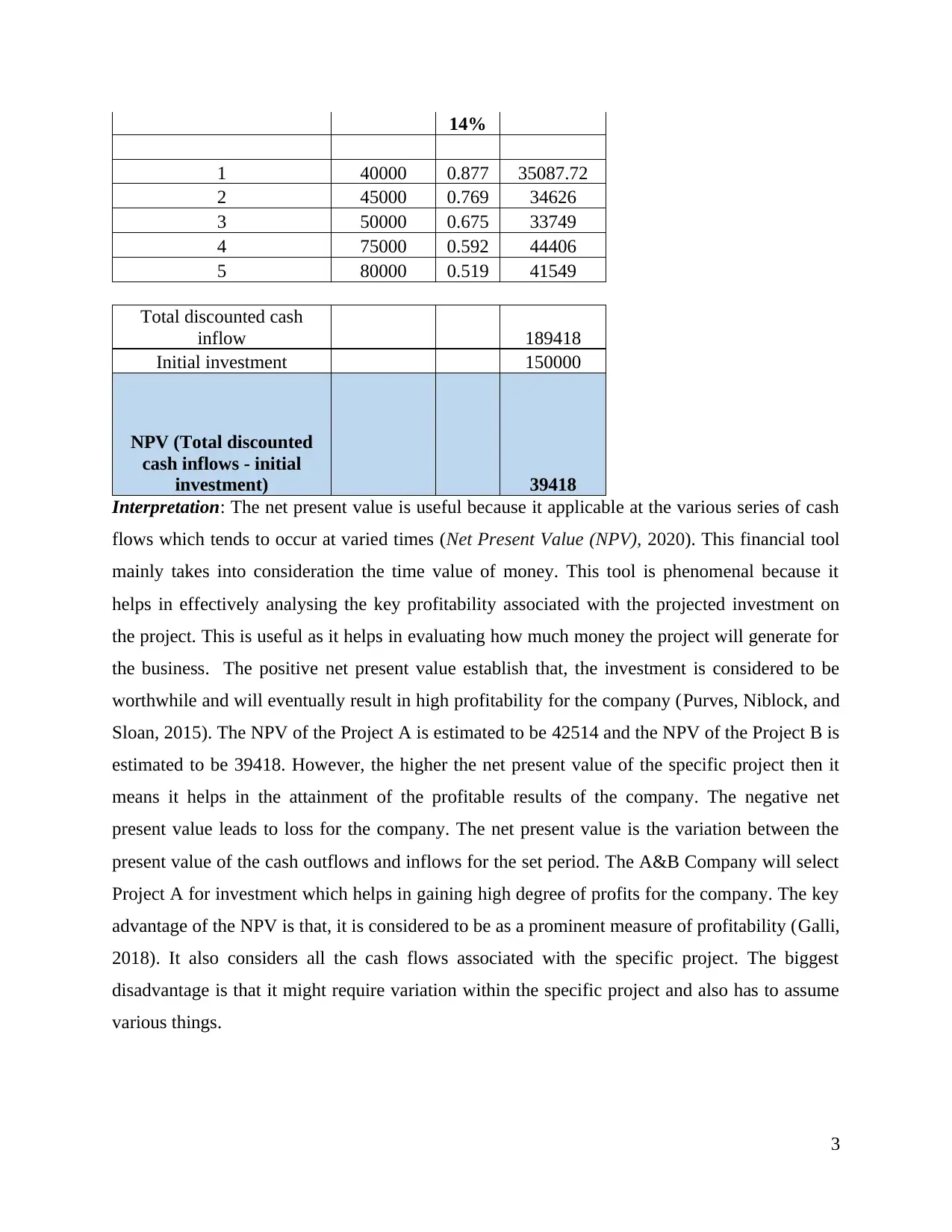
14%
1 40000 0.877 35087.72
2 45000 0.769 34626
3 50000 0.675 33749
4 75000 0.592 44406
5 80000 0.519 41549
Total discounted cash
inflow 189418
Initial investment 150000
NPV (Total discounted
cash inflows - initial
investment) 39418
Interpretation: The net present value is useful because it applicable at the various series of cash
flows which tends to occur at varied times (Net Present Value (NPV), 2020). This financial tool
mainly takes into consideration the time value of money. This tool is phenomenal because it
helps in effectively analysing the key profitability associated with the projected investment on
the project. This is useful as it helps in evaluating how much money the project will generate for
the business. The positive net present value establish that, the investment is considered to be
worthwhile and will eventually result in high profitability for the company (Purves, Niblock, and
Sloan, 2015). The NPV of the Project A is estimated to be 42514 and the NPV of the Project B is
estimated to be 39418. However, the higher the net present value of the specific project then it
means it helps in the attainment of the profitable results of the company. The negative net
present value leads to loss for the company. The net present value is the variation between the
present value of the cash outflows and inflows for the set period. The A&B Company will select
Project A for investment which helps in gaining high degree of profits for the company. The key
advantage of the NPV is that, it is considered to be as a prominent measure of profitability (Galli,
2018). It also considers all the cash flows associated with the specific project. The biggest
disadvantage is that it might require variation within the specific project and also has to assume
various things.
3
1 40000 0.877 35087.72
2 45000 0.769 34626
3 50000 0.675 33749
4 75000 0.592 44406
5 80000 0.519 41549
Total discounted cash
inflow 189418
Initial investment 150000
NPV (Total discounted
cash inflows - initial
investment) 39418
Interpretation: The net present value is useful because it applicable at the various series of cash
flows which tends to occur at varied times (Net Present Value (NPV), 2020). This financial tool
mainly takes into consideration the time value of money. This tool is phenomenal because it
helps in effectively analysing the key profitability associated with the projected investment on
the project. This is useful as it helps in evaluating how much money the project will generate for
the business. The positive net present value establish that, the investment is considered to be
worthwhile and will eventually result in high profitability for the company (Purves, Niblock, and
Sloan, 2015). The NPV of the Project A is estimated to be 42514 and the NPV of the Project B is
estimated to be 39418. However, the higher the net present value of the specific project then it
means it helps in the attainment of the profitable results of the company. The negative net
present value leads to loss for the company. The net present value is the variation between the
present value of the cash outflows and inflows for the set period. The A&B Company will select
Project A for investment which helps in gaining high degree of profits for the company. The key
advantage of the NPV is that, it is considered to be as a prominent measure of profitability (Galli,
2018). It also considers all the cash flows associated with the specific project. The biggest
disadvantage is that it might require variation within the specific project and also has to assume
various things.
3
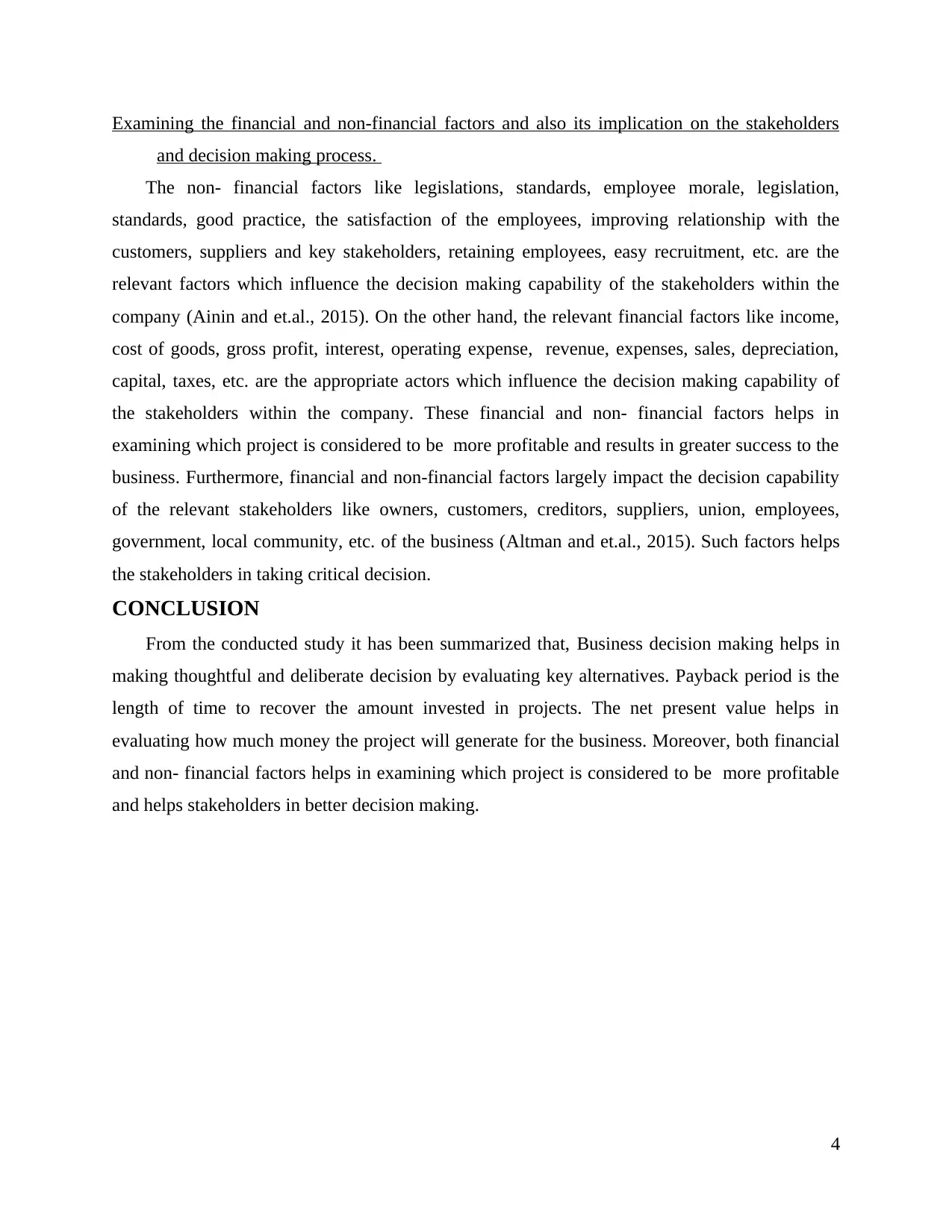
Examining the financial and non-financial factors and also its implication on the stakeholders
and decision making process.
The non- financial factors like legislations, standards, employee morale, legislation,
standards, good practice, the satisfaction of the employees, improving relationship with the
customers, suppliers and key stakeholders, retaining employees, easy recruitment, etc. are the
relevant factors which influence the decision making capability of the stakeholders within the
company (Ainin and et.al., 2015). On the other hand, the relevant financial factors like income,
cost of goods, gross profit, interest, operating expense, revenue, expenses, sales, depreciation,
capital, taxes, etc. are the appropriate actors which influence the decision making capability of
the stakeholders within the company. These financial and non- financial factors helps in
examining which project is considered to be more profitable and results in greater success to the
business. Furthermore, financial and non-financial factors largely impact the decision capability
of the relevant stakeholders like owners, customers, creditors, suppliers, union, employees,
government, local community, etc. of the business (Altman and et.al., 2015). Such factors helps
the stakeholders in taking critical decision.
CONCLUSION
From the conducted study it has been summarized that, Business decision making helps in
making thoughtful and deliberate decision by evaluating key alternatives. Payback period is the
length of time to recover the amount invested in projects. The net present value helps in
evaluating how much money the project will generate for the business. Moreover, both financial
and non- financial factors helps in examining which project is considered to be more profitable
and helps stakeholders in better decision making.
4
and decision making process.
The non- financial factors like legislations, standards, employee morale, legislation,
standards, good practice, the satisfaction of the employees, improving relationship with the
customers, suppliers and key stakeholders, retaining employees, easy recruitment, etc. are the
relevant factors which influence the decision making capability of the stakeholders within the
company (Ainin and et.al., 2015). On the other hand, the relevant financial factors like income,
cost of goods, gross profit, interest, operating expense, revenue, expenses, sales, depreciation,
capital, taxes, etc. are the appropriate actors which influence the decision making capability of
the stakeholders within the company. These financial and non- financial factors helps in
examining which project is considered to be more profitable and results in greater success to the
business. Furthermore, financial and non-financial factors largely impact the decision capability
of the relevant stakeholders like owners, customers, creditors, suppliers, union, employees,
government, local community, etc. of the business (Altman and et.al., 2015). Such factors helps
the stakeholders in taking critical decision.
CONCLUSION
From the conducted study it has been summarized that, Business decision making helps in
making thoughtful and deliberate decision by evaluating key alternatives. Payback period is the
length of time to recover the amount invested in projects. The net present value helps in
evaluating how much money the project will generate for the business. Moreover, both financial
and non- financial factors helps in examining which project is considered to be more profitable
and helps stakeholders in better decision making.
4
⊘ This is a preview!⊘
Do you want full access?
Subscribe today to unlock all pages.

Trusted by 1+ million students worldwide
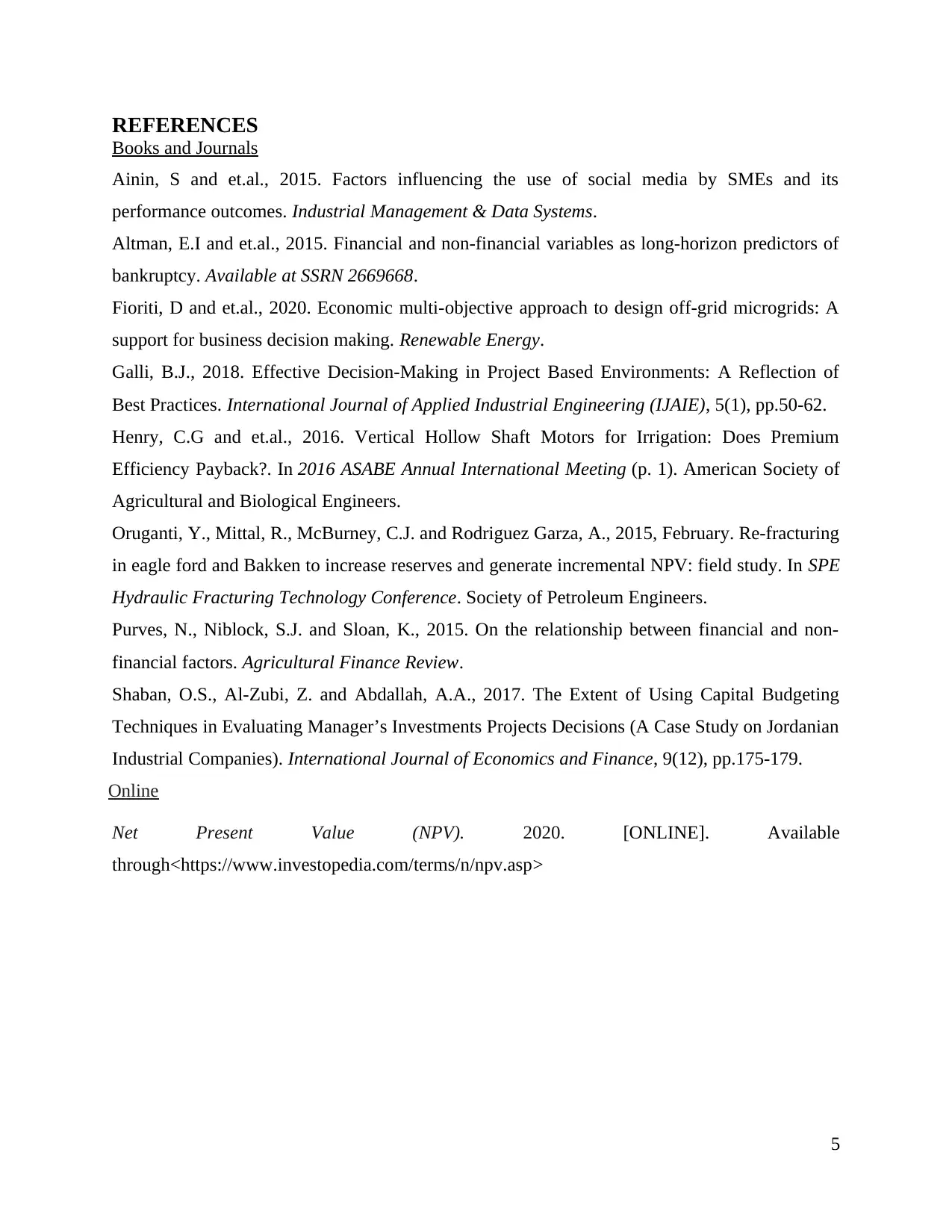
REFERENCES
Books and Journals
Ainin, S and et.al., 2015. Factors influencing the use of social media by SMEs and its
performance outcomes. Industrial Management & Data Systems.
Altman, E.I and et.al., 2015. Financial and non-financial variables as long-horizon predictors of
bankruptcy. Available at SSRN 2669668.
Fioriti, D and et.al., 2020. Economic multi-objective approach to design off-grid microgrids: A
support for business decision making. Renewable Energy.
Galli, B.J., 2018. Effective Decision-Making in Project Based Environments: A Reflection of
Best Practices. International Journal of Applied Industrial Engineering (IJAIE), 5(1), pp.50-62.
Henry, C.G and et.al., 2016. Vertical Hollow Shaft Motors for Irrigation: Does Premium
Efficiency Payback?. In 2016 ASABE Annual International Meeting (p. 1). American Society of
Agricultural and Biological Engineers.
Oruganti, Y., Mittal, R., McBurney, C.J. and Rodriguez Garza, A., 2015, February. Re-fracturing
in eagle ford and Bakken to increase reserves and generate incremental NPV: field study. In SPE
Hydraulic Fracturing Technology Conference. Society of Petroleum Engineers.
Purves, N., Niblock, S.J. and Sloan, K., 2015. On the relationship between financial and non-
financial factors. Agricultural Finance Review.
Shaban, O.S., Al-Zubi, Z. and Abdallah, A.A., 2017. The Extent of Using Capital Budgeting
Techniques in Evaluating Manager’s Investments Projects Decisions (A Case Study on Jordanian
Industrial Companies). International Journal of Economics and Finance, 9(12), pp.175-179.
Online
Net Present Value (NPV). 2020. [ONLINE]. Available
through<https://www.investopedia.com/terms/n/npv.asp>
5
Books and Journals
Ainin, S and et.al., 2015. Factors influencing the use of social media by SMEs and its
performance outcomes. Industrial Management & Data Systems.
Altman, E.I and et.al., 2015. Financial and non-financial variables as long-horizon predictors of
bankruptcy. Available at SSRN 2669668.
Fioriti, D and et.al., 2020. Economic multi-objective approach to design off-grid microgrids: A
support for business decision making. Renewable Energy.
Galli, B.J., 2018. Effective Decision-Making in Project Based Environments: A Reflection of
Best Practices. International Journal of Applied Industrial Engineering (IJAIE), 5(1), pp.50-62.
Henry, C.G and et.al., 2016. Vertical Hollow Shaft Motors for Irrigation: Does Premium
Efficiency Payback?. In 2016 ASABE Annual International Meeting (p. 1). American Society of
Agricultural and Biological Engineers.
Oruganti, Y., Mittal, R., McBurney, C.J. and Rodriguez Garza, A., 2015, February. Re-fracturing
in eagle ford and Bakken to increase reserves and generate incremental NPV: field study. In SPE
Hydraulic Fracturing Technology Conference. Society of Petroleum Engineers.
Purves, N., Niblock, S.J. and Sloan, K., 2015. On the relationship between financial and non-
financial factors. Agricultural Finance Review.
Shaban, O.S., Al-Zubi, Z. and Abdallah, A.A., 2017. The Extent of Using Capital Budgeting
Techniques in Evaluating Manager’s Investments Projects Decisions (A Case Study on Jordanian
Industrial Companies). International Journal of Economics and Finance, 9(12), pp.175-179.
Online
Net Present Value (NPV). 2020. [ONLINE]. Available
through<https://www.investopedia.com/terms/n/npv.asp>
5
1 out of 7
Related Documents
Your All-in-One AI-Powered Toolkit for Academic Success.
+13062052269
info@desklib.com
Available 24*7 on WhatsApp / Email
![[object Object]](/_next/static/media/star-bottom.7253800d.svg)
Unlock your academic potential
Copyright © 2020–2025 A2Z Services. All Rights Reserved. Developed and managed by ZUCOL.





